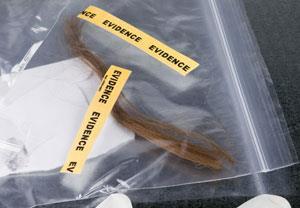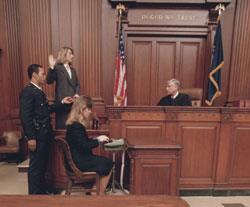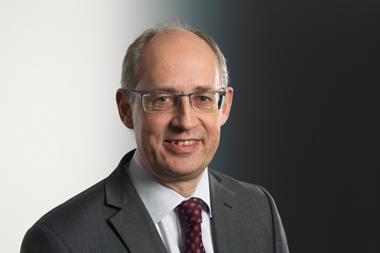When analysing the smallest traces of evidence at a crime scene, chemistry is key. Lisa Melton finds out how chemists can play their part in the justice system
When analysing the smallest traces of evidence at a crime scene, chemistry is key. Lisa Melton finds out how chemists can play their part in the justice system
’Not only his fingerprints or his footprints, but his hair, the fibres from his clothes, the glass he breaks, the paint he scratches, the blood or semen that he deposits or collects - all these bear mute witness against him,’ wrote Paul L Kirk, the ’Father of Criminalistics’, in 1953. Since then, science has made it ever harder for criminals to get away.

In courtrooms the world over, expert witnesses are being thrust into the limelight. The glare of public scrutiny is unexpectedly intense. ’Every time you give evidence, you expect your character to be attacked. Your reputation is at stake. It’s not for the faint-hearted,’ says analytical scientist Tiernan Coyle.
Coyle is a forensic scientist whose evidence helped convict the killers of Nigerian schoolboy Damilola Taylor. It was a difficult case. The 10-year-old boy was stabbed with a broken bottle and bled to death. At the outset, the police went after the usual suspects, but the evidence was flimsy and the first trial was dropped. Years later, a vital new discovery re-opened the inquiry. Two spots of blood had been missed on items belonging to two new suspects. The blood matched Damilola’s profile. Crucially, the suspects’ clothing also contained fibres that matched the schoolboy’s trousers and jumper.
’Fibre transfer happens where contact takes place. So when you find concentrated areas of fibres, you can build up a picture of the type of contact that took place between victim and offender, shortly before or during an attack,’ explains Coyle, then working for Forensic Alliance in Culham (now LGC). The fibre-mapping analysis helped resolve the Damilola Taylor case, and has helped convict three murderers in the past five years.
Coyle’s career in forensics started overseas, when he was hired by the Singaporean Institute of Science and Forensic Medicine, soon after qualifying in analytical chemistry. Still in his 20s, he stepped into the witness box to take the oath on a murder case. Because Singapore has capital punishment, if proven guilty, the individuals sitting in the dock would be executed. ’Even the best analytical scientist can be humbled in the courtroom. It takes more than being a thorough chemist to be an expert witness,’ says Coyle.
Forensic activity was, until recently, dominated by the state-owned Forensic Science Service. But Home Office rules have changed, and private operators can now bid for police work. Coyle, for instance, has set up Contact Traces, a company based in Begbroke, Oxfordshire, UK.
Most entrants into the field begin as assistant scientists, moving on to become a forensic scientist and then a reporting officer, who may have to go to court as an expert witness. Salaries start at about ?14,000 for forensic science assistants and ?15,000 for reporting officers. But senior reporting officers can earn around ?40,000.
Currently the majority of forensic scientists in England and Wales are employed by the Forensic Science Service, which runs the government’s national DNA database. In Scotland, the police employ their own scientists to analyse forensic evidence. Private companies that have developed specific areas of expertise also provide services for the police.
The forensics market is estimated to be worth more than ?220 million a year in England and Wales alone. And it is poised to expand. As ever more sophisticated techniques become available, and with the expansion of the UK’s DNA database, new opportunities will be opened for chemists wanting to be involved in the justice arena and police work.
Expert personality
But it takes more than a science degree to assist the justice process. Scientists must draw on a completely different set of skills to those which their lab-based investigations demand. A flair for public speaking is essential to a would-be expert witness. They must be able explain complex chemical reactions, the working of scientific instruments or medical conditions in simple, everyday language.
This is no mean feat. To convert hard-earned, highly technical scientific knowledge into something that can be understood by the non-scientist jury, lawyers, and judges can be trying. But it is an important talent for anyone wanting to qualify as an expert witness.
Knowledge, of course, matters hugely. It sets an ’expert’ witness apart from an ordinary ’fact’ witness. ’Other witnesses must talk about facts, what they gained through the use of their five senses. They must not give opinions,’ says Tony Moffat, professor in pharmaceutical analysis at the School of Pharmacy, University of London, UK. Forensic scientists don’t just run the tests - they interpret the scientific evidence. ’Expert witnesses, by their very nature are asked to give their opinion,’ he adds.
Then there is self-confidence. ’Lawyers can play games,’ points out an expert witness who would rather remain anonymous. ’Often counsel on both sides will attempt to draw an expert witness away from their core expertise. If they succeed in misleading you, then your entire evidence is discredited. Reputations can be badly damaged.’
Even a seasoned expert witness will acknowledge feeling uncomfortable under cross-examination. Defence lawyers, hoping to find a loophole in the prosecution’s case, poke the scientific evidence - and the scientist presenting it - with vigorous arguments. They might engage their own experts to examine the evidence and draw their own conclusions.
Ultimately, however, the expert witness must deliver the truth, regardless of whom it hurts or helps. As Michael Walker, a former public analyst, puts it: ’The expert’s duty is ultimately to assist the court, no matter what side makes the initial contact or who is footing the bill.’
How to take the oath

For chemists, there are two main routes to the witness stand. Forensics is one, to become a public analyst, the other. At first glance, the connection between food and crime may seem tenuous. Yet in the UK, food law is criminal law. ’Consumer choice, health and even the lives of consumers are potentially at risk from toxic chemicals, and fake drinks and food,’ notes Walker, who was a public analyst for the Government Chemist Programme at LGC, in Middlesex.
Counterfeit alcoholic drinks are a serious concern. ’There’s a large black market industry in counterfeit branded alcoholic drinks. Methanol has been included in some of these drinks, which can cause blindness and death.’ The analysis is painstaking and costly, but justified, Walker insists: ’These are dangerous substances.’ There are currently 29 public analysts’ laboratories in the UK. Local authorities own two thirds of the laboratories and the rest are in private hands. ’Public analysts are the original forensic chemists of the food world and have been protecting the public since the middle of the 19th century,’ he adds.
The CSI effect
Forensic work is mostly about examining samples, sifting through evidence, and running laboratory tests. Hardly as thrilling as an episode of Crime Scene Investigation. Television programmes such as CSI present an exciting, glamorous image of forensic science, and audiences are spellbound. Unfortunately, this interest has also created unrealistic expectations of what an expert witness can produce to catch a criminal.
’All the jurors are now DNA experts. They have seen it on telly and think they know how it should be done,’ says Alec Jeffreys, professor of genetics at the University of Leicester, UK and the inventor of DNA fingerprinting. ’DNA analyses are being thrown out because they are not done to the level that the jury has seen in CSI. They have a model in their mind of how the tests should be conducted. If the investigation doesn’t match that, they get very leery about it. It’s a bizarre phenomenon, but it’s real.’
Increasingly, unless the evidence is presented as video or an animated sequence, the juries are unimpressed. ’You can almost see them deflate in their seat. You are bearing their incredulous disappointment that you can’t provide them with a simple scientific answer to say if the defendant is guilty or not,’ Coyle remarks. The trend is so worrying that in some US courts, potential jurors are asked about their television watching preferences to weed out those who cannot separate fact from fiction.
Rule me out
’A lot of the work forensic scientists do is to eliminate suspects so the police can concentrate on those who might have committed a crime,’ says Moffat, a pharmacist who was lured into the world of forensics aged 22. ’The evidence clears far more people of crime than they ever assist in their conviction. People forget that. If you are saying "no, this blood stain did not come from that person," then they are not a suspect any more.’
Chemists working in forensics have a varied job. They may have to tackle paint, chemicals, plastics, drugs and banned substances, and spend time reconstructing arson incidents or car accidents. When examining crime scenes, there is a fair degree of cross-over work, analysing biological samples such as hair or body fluids. ’Whether you are a chemist, botanist, pharmacist, biologist, or physicist, the area is so wide you can be trained in any particular area of forensic science that you like,’ Moffat notes.
Moffat recalls how a forensic lab technician contemplating suicide boasted that no one, not even his colleagues, would uncover the poison he would use to kill himself. One weekend his mother found him dead. The tests took a long time, and eventually uncovered fluoroacetate. ’Someone may think they have poisoned themselves, or committed murder, using a poison that cannot possibly be detected, but with enough time, you will find out what it is,’ Moffat insists.
There are frustrations inherent to the job: expert witnesses are often forced to hang around courtrooms for hours, and holidays are often disrupted. But as Moffat notes: ’Being an expert witness is about using your scientific talent for the public good.’ And with today’s techniques and instrumentation on their side, expert witnesses are making science speak louder than ever.
Lisa Melton is a freelance writer based in London, UK
Further Reading
- The Forensic Science Service
- The Forensic Science Society
- For information on pursuing a career as a public analyst, including information on the statutory qualificatio
- P C White, Crime Scene to Court: The Essentials of Forensic Science 2nd Edition, London: RSC, 2004
DNAdivination
Few scientists are as familiar with the courtroom as Alec Jeffreys, the discoverer of DNA fingerprinting
’By the afternoon of that first day, I was running around the room leaving blood spots round the lab,’ says Alec Jeffreys of the University of Leicester, recalling the frenzy triggered by those first DNA patterns back in 1984. Blood and crime, guilt and innocence, were racing through his mind. ’We had no idea whether this would work on a forensic case. We didn’t even know if DNA survived in forensic specimens,’ says Jeffreys, who studied biochemistry at the University of Oxford, UK and later became professor of genetics at the University of Leicester.
It was an accident. The first DNA fingerprint was unexpected. But within minutes of pulling the autoradiograph film out of the tank, Jeffreys realised he had stumbled on a technique with profound societal implications. ’It completely shot us in a different direction. It was an extraordinary experience.’
From paternity disputes, and identifying massacre victims, to asking if some old bones are truly the remains of the last Czar of Russia, the potential for biological identification has revolutionised the world.
Most lawyers and judges are now DNA savvy, but two decades ago, DNA fingerprinting was a puzzling, new technology. Law courts simply didn’t know what DNA was, or how to tackle DNA testing. ’I would get some very strange questions, for instance, "Do restriction enzymes have a genome?"; "Can we liken DNA to the rim of a Ming vase?"’ he recalls.
Knowledge gaps aside, the police took to DNA evidence with astonishing speed. There had been two murders in a nearby village and Jeffreys was asked if he could match semen DNA from the victims to the DNA of the prime suspect who had confessed to one of the murders. Sir Alec ran the tests and found a total mismatch, exonerating an innocent man who most likely would have been jailed for the rest of his life. Instead, the scientific evidence led to another man, Colin Pitchfork, who became the first man arrested as a result of DNA.
These were heady days, but Jeffreys admits court appearances were not easy. ’I found the adversarial nature of the legal system exceedingly difficult. It was never comfortable being an expert witness. What they are looking for is a simple "yes-no" answer. That’s not how science works.’
DNA fingerprinting is now a routine forensic test. Laboratories around the country are churning out DNA results every day, and as a result, each year some 20,000 criminals are caught and convicted. And the same technique is exonerating wrongfully convicted prisoners. ’I had the privilege of meeting one of the first people to be exonerated by DNA. He’d spent two years on death row. A horrendous story,’ Jeffreys says.
What advice would he give a would-be expert witness? ’Become knowledgeable in the law, understand court procedure. And never, ever, stray outside your area of expertise.’
He admits, however, that there is a clash of cultures between science and the law. ’The very concept of what we consider evidence is quite different to what that very same word means in a court of law.’
But it takes more than a radical new technology to make an expert witness. ’You don’t arrive at a crime science to find a little bottle waiting for you labelled "DNA". Context is everything. If you do find matching DNA, there could be an innocent explanation such as passive transfer.’ An expert witness has the knowledge to help work it out.
Also of interest
Mastership in Chemical Analysis (MChemA)
The statutory qualification for practice as a Public Analyst in the UK







No comments yet